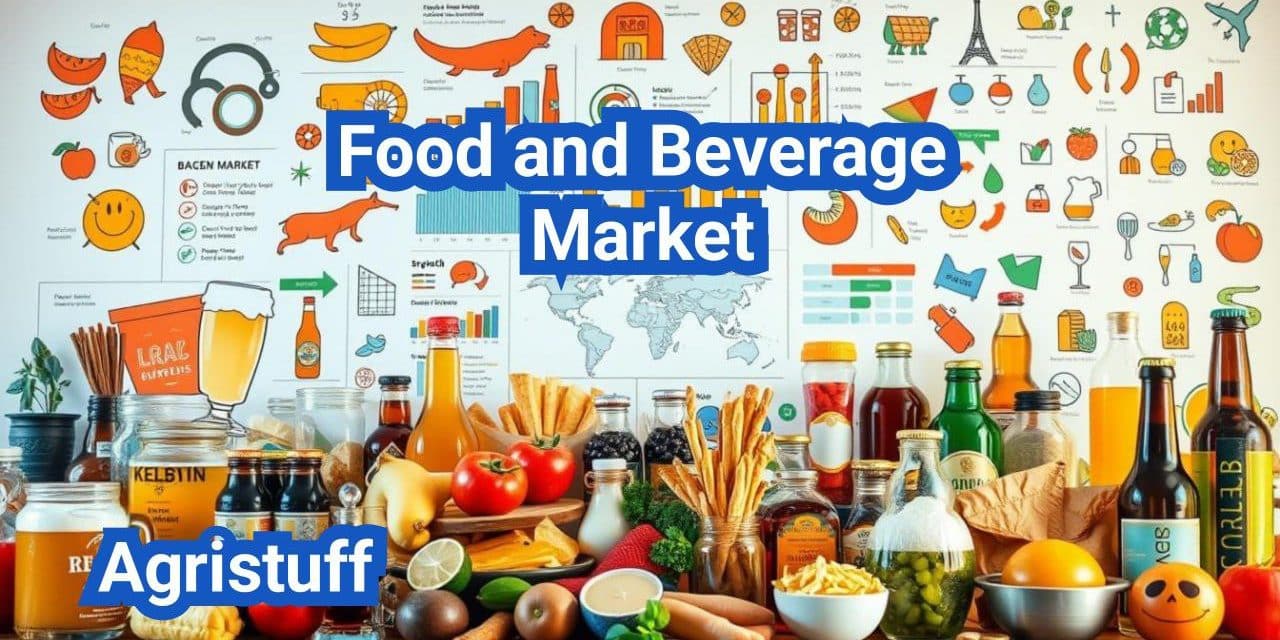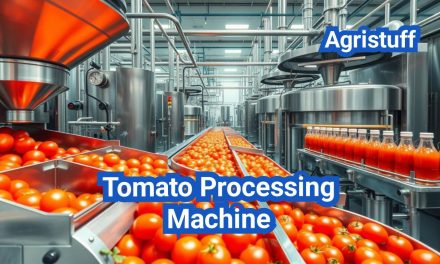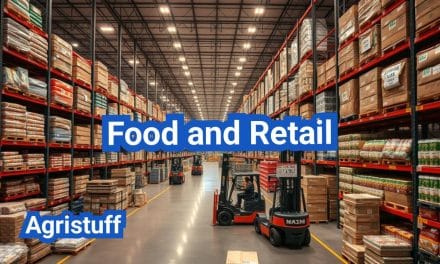The U.S. food and beverage industry has experienced significant growth in recent years, driven by changing consumer preferences and advancements in technology. As of 2022, the U.S. food and beverage market was valued at US$680.2 billion, with a compound annual growth rate (CAGR) of 3.6% from 2017 to 2025.
The industry’s growth is influenced by various factors, including shifting consumer behavior and emerging market trends. As consumers become more health-conscious and environmentally aware, companies are adapting their strategies to meet these new demands.
Key Takeaways
- The U.S. food and beverage market is valued at US$680.2 billion as of 2022.
- The industry has seen a CAGR of 3.6% from 2017 to 2022.
- Changing consumer behavior is driving growth in the industry.
- Emerging market trends are influencing the industry’s development.
- Companies are adapting to new consumer demands.
Current State of the U.S. Food and Beverage Market
The current landscape of the U.S. food and beverage market is characterized by its vast size and diverse consumer base. As a significant sector of the U.S. economy, the food and beverage industry is subject to various trends, challenges, and opportunities that shape its current state.
Market Size and Valuation Statistics
The U.S. food and beverage market is substantial, with a projected growth rate of 5.0% from 2022 to 2027. By 2027, the market is expected to reach a valuation of US$869.1 billion. This growth is driven by various factors, including changing consumer preferences, advancements in food technology, and shifts in economic conditions.
The market’s valuation is a critical indicator of its health and potential for future growth. Key statistics include:
- Projected market value by 2027: US$869.1 billion
- Growth rate from 2022 to 2027: 5.0%
- Increasing demand for premium and specialty food products
Key Market Segments and Categories
The U.S. food and beverage market is diverse, comprising various segments and categories. Some of the key segments include:
- Beverages: Soft drinks, juices, coffee, and tea
- Packaged Foods: Snacks, baked goods, and ready-to-eat meals
- Fresh Produce: Fruits and vegetables
- Dairy and Alternatives: Milk, cheese, and plant-based alternatives
These segments are experiencing different growth rates and trends, influenced by consumer preferences and dietary habits.
Regional Distribution Across the U.S.
The U.S. food and beverage market exhibits regional variations, influenced by factors such as demographics, cultural preferences, and economic conditions. Key regions include:
| Region | Characteristics | Market Trends |
|---|---|---|
| Northeast | Diverse population, high income | Strong demand for premium products |
| South | Large population, diverse cuisine | Growing demand for convenience foods |
| West Coast | Health-conscious consumers, diverse | Increasing demand for organic and plant-based products |
Understanding these regional differences is crucial for businesses aiming to capitalize on the opportunities within the U.S. food and beverage market.
How to Analyze the Food and Beverage Market Structure

To navigate the highly competitive U.S. food and beverage market, businesses must first analyze its structure. This involves understanding the various components that make up the market, including the major players, distribution channels, and regulatory frameworks.
Identifying Major Industry Players
The U.S. food and beverage market is dominated by large corporations such as McDonald’s Corp and chained foodservice franchises. To identify major industry players, businesses can conduct market research to analyze market share, revenue, and consumer preferences. This information can be obtained through market research reports, industry analysis, and consumer surveys.
For instance, a company looking to enter the beverage market can analyze the market share of major players like Coca-Cola and PepsiCo to understand the competitive landscape.
Mapping Distribution Channels
Understanding the distribution channels is crucial for businesses to reach their target audience effectively. The U.S. food and beverage market utilizes various distribution channels, including supermarkets, online platforms, and foodservice providers. Businesses can map these channels by analyzing the supply chain, logistics, and distribution networks.
For example, a food manufacturer can identify key distributors and retailers to ensure their products are widely available in the market.
Understanding Regulatory Frameworks
The food and beverage industry is heavily regulated by government agencies such as the FDA and USDA. Understanding these regulatory frameworks is essential for businesses to comply with food safety standards, labeling requirements, and other regulations. Companies can stay informed about regulatory changes through industry associations, government websites, and legal counsel.
By analyzing the market structure, businesses can identify opportunities and challenges, ultimately informing their strategies to succeed in the competitive U.S. food and beverage market.
Leveraging Primary Growth Drivers in the U.S. Market
As the U.S. economy continues to evolve, factors such as consumer spending, technological integration, and demographic changes play crucial roles in shaping the food and beverage industry. The U.S. food and beverage market is poised for significant growth, driven by various economic, technological, and demographic factors.
Capitalizing on Economic Factors
Economic stability and growth have a direct impact on the food and beverage market. In 2022, the U.S. economy grew by 2.1%, with consumer spending accounting for approximately two-thirds of the country’s GDP. This economic growth translates into increased consumer expenditure on food and beverages.
Key economic factors influencing the market include:
- Consumer spending habits
- Employment rates
- Disposable income levels
| Economic Indicator | 2022 Data | Impact on Food & Beverage Market |
|---|---|---|
| GDP Growth Rate | 2.1% | Increased consumer spending |
| Consumer Spending | ~2/3 of GDP | Higher demand for food and beverages |
| Employment Rate | High employment | Increased disposable income |
Implementing Technological Advancements
Technological innovations are transforming the food and beverage industry. From production and processing to distribution and consumption, technology is enhancing efficiency, reducing costs, and improving consumer experiences.
Some key technological advancements include:
- Automation in manufacturing
- E-commerce platforms
- Digital payment systems
Adapting to Demographic Shifts
Demographic changes, such as aging populations, urbanization, and changing household structures, are influencing consumer preferences and behaviors in the food and beverage market.
Key demographic shifts include:
- Aging population
- Increasing urbanization
- Diverse household structures
By understanding and adapting to these demographic shifts, businesses can tailor their products and services to meet the evolving needs of consumers.
How to Respond to Consumer Trends Reshaping the Industry

Consumer preferences are reshaping the food and beverage landscape, necessitating adaptive strategies for industry success. The modern consumer is more informed, health-conscious, and environmentally aware than ever before, driving demand for products that align with these values.
Addressing Health and Wellness Priorities
Consumers are increasingly prioritizing health and wellness in their food choices. To respond to this trend, companies can reformulate products to reduce sugar, salt, and unhealthy fats, while increasing the nutritional value. Clean labeling is also becoming more important, with consumers seeking products with fewer, more recognizable ingredients.
Some key strategies for addressing health and wellness priorities include:
- Developing products with functional benefits, such as probiotics or added vitamins and minerals
- Using natural ingredients and avoiding artificial additives
- Creating products that cater to specific dietary needs, such as gluten-free or vegan options
Developing Convenience-Focused Products
The demand for convenience is driving growth in the food and beverage industry. Consumers are seeking products that are easy to consume on-the-go, with minimal preparation required. To capitalize on this trend, companies can develop products with portable packaging and convenient formats, such as single-serve portions or ready-to-eat meals.
| Convenience Feature | Product Examples | Benefits |
|---|---|---|
| Portable Packaging | Single-serve snack packs, bottled beverages | Easier to consume on-the-go |
| Ready-to-Eat Formats | Pre-cooked meals, microwaveable bowls | Minimal preparation required |
| Easy-to-Open Packaging | Easy-peel packaging, resealable containers | Enhanced user experience |
Implementing Sustainability Initiatives
Sustainability is becoming a key consideration for consumers when making food and beverage choices. Companies can respond to this trend by implementing sustainable sourcing practices, reducing packaging waste, and developing products with environmentally friendly ingredients.
Some effective sustainability initiatives include:
- Using recyclable or biodegradable packaging materials
- Implementing energy-efficient manufacturing processes
- Sourcing ingredients from environmentally responsible suppliers
By addressing health and wellness priorities, developing convenience-focused products, and implementing sustainability initiatives, food and beverage companies can effectively respond to consumer trends reshaping the industry.
Steps to Enter the Organic Food and Beverage Segment
With the organic food and beverage market projected to grow by 14% by 2025, understanding the steps to enter this segment is crucial for businesses looking to expand their market share. Entering this market requires a strategic approach, focusing on assessing market opportunities, navigating certification requirements, and building consumer trust.
Assessing Organic Market Opportunities
The first step in entering the organic food and beverage segment is to assess the market opportunities. This involves analyzing consumer trends, understanding the competitive landscape, and identifying gaps in the market that your product can fill. Key areas to focus on include the growing demand for organic products, the rise of online shopping, and the increasing importance of sustainability.
A detailed analysis of market statistics can provide insights into the potential for growth. For instance, understanding the current market size, growth rates, and consumer demographics can help in making informed decisions.
| Market Indicator | Current Status | Projected Growth |
|---|---|---|
| Market Size | $100 billion | $150 billion by 2025 |
| Growth Rate | 8% annually | 14% by 2025 |
| Consumer Demand | High | Increasing |
Navigating Organic Certification Requirements
To enter the organic food and beverage market, businesses must navigate the complex process of organic certification. This involves complying with the regulations set by the relevant authorities, such as the USDA National Organic Program (NOP) in the United States. The certification process ensures that products labeled as “organic” meet strict standards regarding the use of synthetic fertilizers, pesticides, and genetically modified organisms (GMOs).
The steps to achieve organic certification include:
- Reviewing and understanding the organic standards
- Preparing and submitting an application
- Undergoing an on-site inspection
- Receiving certification upon compliance
Building Consumer Trust in Organic Products
Building consumer trust is critical for success in the organic food and beverage segment. Consumers need to be confident that the products they purchase are genuinely organic and meet their expectations for quality and sustainability. Transparency in labeling, sourcing, and production processes can significantly enhance consumer trust.
Strategies to build consumer trust include:
- Clear and transparent labeling
- Engaging with consumers through social media and other channels
- Providing detailed information about sourcing and production
By following these steps and focusing on quality, businesses can establish a strong presence in the organic food and beverage market, capitalizing on the growing consumer demand for organic products.
Strategies for Success in the Plant-Based Category

Capitalizing on the plant-based trend requires a deep understanding of consumer behavior, market potential, and effective marketing strategies. The plant-based category is rapidly evolving, driven by consumer demand for healthier, more sustainable, and environmentally friendly food options.
Evaluating Plant-Based Market Potential
To succeed in the plant-based category, businesses must first evaluate the market potential. This involves analyzing consumer trends, understanding the competitive landscape, and identifying opportunities for growth. Key factors to consider include the increasing popularity of vegan and flexitarian diets, the rise of plant-based alternatives to traditional meat and dairy products, and the growing demand for sustainable packaging.
Market Potential Statistics:
| Category | 2022 Market Size | Projected Growth Rate |
|---|---|---|
| Plant-Based Meat Alternatives | $4.6 billion | 12% CAGR |
| Plant-Based Dairy Alternatives | $3.8 billion | 10% CAGR |
| Plant-Based Snacks | $2.1 billion | 8% CAGR |
Developing Competitive Plant-Based Products
Developing competitive plant-based products requires a focus on quality, taste, and nutritional value. Companies should invest in research and development to create products that not only meet but exceed consumer expectations. This can involve using innovative ingredients, improving texture and flavor, and ensuring that products are free from common allergens and artificial additives.
Innovative Plant-Based Ingredients:
- Pea protein
- Rice protein
- Mushroom-based ingredients
- Algal protein
Marketing to Plant-Based Consumers
Effective marketing to plant-based consumers involves understanding their values, preferences, and behaviors. Companies should leverage digital marketing channels, social media, and influencer partnerships to reach their target audience. Messaging should emphasize the health, environmental, and ethical benefits of plant-based products, while also highlighting their taste and convenience.
Marketing Strategies:
- Utilize social media platforms to engage with consumers and promote products.
- Partner with influencers and bloggers in the plant-based community.
- Develop clear, compelling messaging that resonates with plant-based consumers.
- Invest in targeted online advertising to reach potential customers.
How to Optimize E-Commerce Presence for Food and Beverages

Optimizing e-commerce presence is crucial for food and beverage businesses looking to expand their market reach and improve customer engagement. As the online shopping landscape continues to evolve, companies must adapt their strategies to remain competitive.
Building an Effective Online Retail Strategy
A well-planned online retail strategy is essential for food and beverage businesses to succeed in e-commerce. This involves understanding consumer behavior, selecting the right e-commerce platforms, and optimizing product listings for better visibility.
Key Components of an Online Retail Strategy:
- Market research and analysis
- Selection of e-commerce platforms
- Product listing optimization
- Digital marketing and promotion
By focusing on these areas, businesses can create a robust online presence that attracts and retains customers.
Implementing Direct-to-Consumer Models
Direct-to-consumer (DTC) models allow food and beverage businesses to sell products directly to customers, bypassing traditional retail channels. This approach can help companies build stronger relationships with their customers and improve profit margins.
| Benefits of DTC Models | Description |
|---|---|
| Increased Customer Engagement | Direct interaction with customers allows for better understanding of their needs and preferences. |
| Improved Profit Margins | By eliminating intermediaries, businesses can retain a larger share of the revenue. |
| Enhanced Brand Control | DTC models enable companies to maintain control over their brand image and customer experience. |
Creating Seamless Omnichannel Experiences
Omnichannel experiences involve integrating multiple sales channels to provide a cohesive and convenient shopping experience for customers. For food and beverage businesses, this means ensuring that customers can seamlessly transition between online and offline channels.
Strategies for Omnichannel Experiences:
- Implementing unified inventory management systems
- Offering consistent pricing across channels
- Providing flexible fulfillment options (e.g., in-store pickup, delivery)
By adopting these strategies, food and beverage businesses can optimize their e-commerce presence, improve customer satisfaction, and drive sales growth.
Conducting Effective Food and Beverage Market Research

Market research plays a pivotal role in helping food and beverage companies stay ahead of consumer trends and competitor activity. In the ever-evolving U.S. food and beverage market, understanding consumer behavior, market trends, and competitor strategies is crucial for business success.
Designing Primary Research Studies
Primary research studies involve collecting original data directly from consumers, industry experts, or through observational studies. To design effective primary research, consider the following:
- Define clear research objectives: Identify what you want to achieve through your research, whether it’s understanding consumer preferences or assessing market demand.
- Choose appropriate methodologies: Select from surveys, focus groups, interviews, or observational studies based on your research objectives.
- Ensure representative sampling: Make sure your sample size is adequate and representative of your target market to draw meaningful conclusions.
Utilizing Secondary Data Sources
Secondary data sources provide valuable insights from existing research, industry reports, and market data. To effectively utilize secondary data:
- Identify credible sources: Look for data from reputable sources such as industry associations, government reports, and academic journals.
- Analyze market trends: Use secondary data to understand historical market trends and forecast future developments.
- Benchmark against competitors: Compare your company’s performance with industry averages and competitor data.
Applying Consumer Insight Tools
Consumer insight tools help businesses understand consumer behavior, preferences, and pain points. Some effective tools include:
- Social media listening tools: Analyze consumer conversations on social media to gauge sentiment and identify trends.
- Customer feedback platforms: Collect and analyze customer feedback to improve products and services.
- Market segmentation tools: Segment your market to tailor your marketing strategies to specific consumer groups.
By combining primary research studies, secondary data sources, and consumer insight tools, food and beverage companies can gain a comprehensive understanding of the market and make informed strategic decisions.
Developing Winning Food and Beverage Marketing Strategies

The key to thriving in the U.S. food and beverage market lies in creating and executing winning marketing strategies. To achieve this, companies must understand their target audience, stay abreast of industry trends, and leverage a mix of digital and traditional marketing channels.
Creating Effective Digital Marketing Campaigns
Digital marketing has become a cornerstone for food and beverage brands looking to engage with consumers. Effective digital marketing campaigns involve a multi-faceted approach, including:
- Social media advertising to target specific demographics
- Email marketing to nurture customer relationships
- Search engine optimization (SEO) to improve online visibility
- Influencer partnerships to reach wider audiences
For instance, a food brand might launch a social media campaign featuring engaging content and influencer collaborations to promote a new product. By tracking engagement metrics and adjusting the campaign in real-time, brands can optimize their marketing spend.
Leveraging Social Media and Influencers
Social media platforms offer a unique opportunity for food and beverage brands to connect with consumers. By creating engaging content and leveraging influencer marketing, brands can build a loyal following. A well-executed social media strategy involves:
- Identifying the right platforms for your target audience
- Creating content that resonates with your audience
- Engaging with followers through comments and direct messages
- Monitoring analytics to refine your content strategy
For example, a beverage company might partner with a popular fitness influencer to promote a new low-calorie drink, resulting in increased brand awareness and sales.
Integrating Traditional Marketing Channels
While digital marketing is crucial, traditional marketing channels still play a significant role in the food and beverage industry. Television advertising, print media, and in-store promotions continue to be effective ways to reach consumers. By integrating these channels with digital marketing efforts, brands can create a cohesive marketing strategy.
| Marketing Channel | Benefits | Examples |
|---|---|---|
| Digital Marketing | Targeted advertising, real-time analytics | Social media ads, email campaigns |
| Traditional Marketing | Broad reach, brand credibility | TV commercials, print ads, in-store displays |
| Integrated Marketing | Comprehensive strategy, enhanced engagement | Combining digital and traditional channels |
By understanding the strengths of each marketing channel and integrating them effectively, food and beverage brands can develop winning marketing strategies that drive growth and consumer loyalty.
Competing in the Private Label Segment of U.S. Grocery
To succeed in the private label segment, businesses must analyze market opportunities and develop effective strategies. The private label segment is a significant and growing part of the U.S. grocery market, offering retailers a way to differentiate themselves and increase profit margins.
Analyzing Private Label Market Opportunities
Understanding the current landscape of the private label segment is crucial. This involves analyzing consumer trends, market size, and growth potential. Market research can help identify areas of opportunity, such as categories with high demand for private label products.
Retailers can capitalize on the trend towards premium private label products by developing high-quality offerings that compete with national brands.
Developing Premium Private Label Products
Creating premium private label products requires a focus on quality, packaging, and branding. Retailers should invest in product development to create offerings that are competitive with national brands.
- Conduct consumer research to understand preferences
- Invest in high-quality ingredients and manufacturing processes
- Develop attractive and distinctive packaging
Creating Effective Retailer Partnerships
Building strong partnerships with retailers is essential for success in the private label segment. This involves collaborating on product development, marketing strategies, and supply chain optimization.
Effective retailer partnerships can lead to increased sales and improved brand loyalty. Retailers can work with suppliers to develop exclusive products and promotions.
How to Navigate Food Price Inflation

Navigating the complexities of food price inflation is crucial for businesses in the U.S. food and beverage market. Food price inflation, driven by factors such as supply chain disruptions and commodity price volatility, poses significant challenges for companies aiming to maintain profitability and competitiveness.
Forecasting and Monitoring Price Trends
To effectively navigate food price inflation, businesses must first develop the ability to forecast and monitor price trends. This involves analyzing historical data, understanding current market conditions, and staying informed about future market projections. By leveraging advanced data analytics tools, companies can gain valuable insights into price movements and make informed decisions.
Key strategies for forecasting and monitoring price trends include:
- Utilizing advanced data analytics to identify patterns and predict future price changes.
- Staying abreast of market news and trends that could impact commodity prices.
- Engaging with industry experts and participating in relevant forums to gather insights.
Adjusting Pricing and Promotion Strategies
As food price inflation impacts the market, adjusting pricing and promotion strategies becomes essential. Companies must balance the need to maintain profitability with the necessity of remaining competitive. This may involve implementing price adjustments, offering targeted promotions, or revising product packaging to manage costs.
Effective strategies include:
- Implementing dynamic pricing models that can respond to changes in commodity prices.
- Developing targeted promotional campaigns to retain customer loyalty.
- Reviewing and adjusting product offerings to optimize profitability.
Optimizing Cost Structure and Efficiency
Optimizing cost structure and efficiency is critical for mitigating the impact of food price inflation. By streamlining operations, reducing waste, and improving supply chain management, businesses can minimize the effects of rising costs. Investing in technology and process improvements can also enhance efficiency and reduce expenses.
Key areas to focus on include:
- Improving supply chain resilience through diversification and strategic partnerships.
- Investing in automation and technology to reduce labor costs and enhance productivity.
- Implementing cost-saving initiatives across the organization.
Capitalizing on Foodservice Industry Evolution

The foodservice industry is undergoing a significant transformation, driven by changing consumer preferences and technological advancements. To capitalize on this evolution, businesses must understand the key drivers behind its transformation, including technology and consumer trends.
Identifying Restaurant Sector Opportunities
The restaurant sector presents numerous opportunities for growth, particularly in areas that cater to changing consumer behaviors. Key trends include:
- Increased demand for convenience and delivery services
- Growing interest in health and wellness-oriented menu options
- Rise of experiential dining experiences
According to a recent report, the restaurant industry is expected to see a significant shift towards off-premise dining, with delivery and takeout becoming increasingly popular.
“The future of the restaurant industry lies in its ability to adapt to changing consumer preferences, leveraging technology to enhance the dining experience.”
National Restaurant Association
Developing Products for Ghost Kitchens and Delivery
The rise of ghost kitchens and delivery services has transformed the way food is prepared and consumed. To capitalize on this trend, businesses should focus on developing products that are optimized for delivery and takeout.
| Product Characteristics | Ideal for Delivery/Takeout |
|---|---|
| Packaging | Durable, leak-proof, and visually appealing |
| Menu Items | Items that travel well, such as bowls, sandwiches, and finger foods |
| Flavor Profile | Robust flavors that can withstand transportation |
Integrating Technology in Foodservice Offerings
Technology integration is crucial in the evolving foodservice industry, enhancing the customer experience and streamlining operations. Key technologies include:
- Online ordering and payment systems
- Mobile apps for ordering and loyalty programs
- Kitchen technology, such as automated cooking systems
By embracing these technologies, foodservice providers can improve efficiency, reduce costs, and enhance customer satisfaction.
Building Successful Consumer Packaged Goods Strategies

Building a successful CPG strategy requires a deep understanding of consumer trends, product development, and supply chain resilience. In today’s competitive market, consumer packaged goods companies must adapt to changing consumer behavior and preferences to remain relevant.
Creating Innovative Product Development Processes
Innovative product development is crucial for CPG companies to stay competitive. This involves understanding consumer needs and preferences, leveraging market trends, and utilizing technologies to create products that meet evolving demands. Companies should focus on developing products that are not only of high quality but also align with consumer values such as sustainability and health.
To achieve this, CPG companies can implement agile product development methodologies, allowing for quicker iteration and adaptation to consumer feedback. Collaboration with consumers through social media and other channels can provide valuable insights into their needs and preferences.
Optimizing Supply Chain for Resilience
A resilient supply chain is essential for CPG companies to ensure consistent product delivery and maintain customer trust. This involves diversifying suppliers, investing in supply chain visibility technologies, and developing contingency plans for potential disruptions.
- Implementing advanced analytics to predict and mitigate supply chain risks.
- Developing strong relationships with suppliers to ensure reliability and flexibility.
- Investing in technologies such as blockchain to enhance supply chain transparency.
Developing Distinctive Brand Positioning
Distinctive brand positioning is critical for CPG companies to stand out in a crowded market. This involves creating a unique brand identity that resonates with target consumers and differentiates the brand from competitors.
Effective brand positioning can be achieved through a combination of compelling brand storytelling, consistent visual identity, and delivering on brand promises. CPG companies should also leverage digital marketing channels to engage with consumers and build brand awareness.
By focusing on innovative product development, supply chain resilience, and distinctive brand positioning, CPG companies can build successful strategies that drive growth and profitability in a competitive market.
Future Outlook for the U.S. Food and Beverage Market
The U.S. food and beverage market is poised for continued growth, driven by evolving consumer preferences and technological advancements. As consumers increasingly prioritize health, wellness, and convenience, industry players must adapt to these changing demands.
Market trends indicate a sustained focus on sustainability, with consumers seeking products and packaging that minimize environmental impact. The rise of e-commerce and direct-to-consumer models is also transforming the way food and beverages are marketed and sold.
Industry forecasts suggest that the U.S. food and beverage market will remain dynamic, with opportunities emerging in areas such as plant-based products, organic offerings, and innovative foodservice concepts. To capitalize on these trends, businesses must stay attuned to consumer behavior and preferences, leveraging data-driven insights to inform product development, marketing strategies, and supply chain optimization.
As the market continues to evolve, companies that prioritize agility, innovation, and consumer-centricity are likely to thrive in the U.S. food and beverage industry’s future outlook.
FAQ
What is the current state of the U.S. food and beverage market?
The U.S. food and beverage market is experiencing significant growth, driven by factors such as economic stability, technological advancements, and shifting consumer preferences.
What are the key segments in the U.S. food and beverage market?
The key segments in the U.S. food and beverage market include organic food, plant-based products, private label grocery, and foodservice industry.
How is the U.S. food and beverage market distributed regionally?
The U.S. food and beverage market is distributed across various regions, with different areas having distinct consumer preferences and market trends.
What are the primary growth drivers in the U.S. food and beverage market?
The primary growth drivers in the U.S. food and beverage market include economic factors, technological advancements, and demographic shifts.
How can companies respond to consumer trends in the food and beverage industry?
Companies can respond to consumer trends by addressing health and wellness priorities, developing convenience-focused products, and implementing sustainability initiatives.
What steps can be taken to enter the organic food and beverage segment?
To enter the organic food and beverage segment, companies should assess market opportunities, navigate certification requirements, and build consumer trust.
How can companies succeed in the plant-based category?
Companies can succeed in the plant-based category by evaluating market potential, developing competitive products, and marketing to plant-based consumers.
What is the importance of e-commerce in the food and beverage market?
E-commerce is crucial in the food and beverage market, as it allows companies to build an effective online retail strategy, implement direct-to-consumer models, and create seamless omnichannel experiences.
How can companies conduct effective food and beverage market research?
Companies can conduct effective food and beverage market research by designing primary research studies, utilizing secondary data sources, and applying consumer insight tools.
What are the key elements of a winning food and beverage marketing strategy?
A winning food and beverage marketing strategy involves creating effective digital marketing campaigns, leveraging social media and influencers, and integrating traditional marketing channels.
How can companies compete in the private label segment of U.S. grocery?
Companies can compete in the private label segment by analyzing market opportunities, developing premium products, and creating effective retailer partnerships.
How can companies navigate food price inflation?
Companies can navigate food price inflation by forecasting and monitoring price trends, adjusting pricing and promotion strategies, and optimizing cost structure and efficiency.
What opportunities are available in the foodservice industry?
Opportunities in the foodservice industry include identifying restaurant sector opportunities, developing products for ghost kitchens and delivery, and integrating technology in foodservice offerings.
How can companies build successful consumer packaged goods strategies?
Companies can build successful consumer packaged goods strategies by creating innovative product development processes, optimizing supply chain for resilience, and developing distinctive brand positioning.
What is the future outlook for the U.S. food and beverage market?
The future outlook for the U.S. food and beverage market is positive, with continued growth expected driven by consumer trends, technological advancements, and industry innovation.
Conclusion of: U.S. Food and Beverage Market
U.S. Food and Beverage Market: Why It Matters Right Now
The U.S. food and beverage market is a pillar of the consumer economy, connecting farms, processors, distributors, retailers, and restaurants in one of the most efficient supply chains in the world. Households in the United States allocate a meaningful share of disposable income to food at home and food away from home, and that spend is a crucial signal for category managers, marketers, and plant operators planning capacity and innovation. Beyond dollars, the food and beverage market sets the pace for packaging trends, logistics investments, and workforce needs across every state. USDA ERS – Food Expenditure Series
Market Size: The Scale of Daily Demand
When leaders talk about the size of the U.S. food and beverage market, they are capturing total consumer outlays across retail grocery, convenience, mass, club, e-commerce, and foodservice. Taken together, those channels create a multi-trillion-dollar baseline that grows with population, wages, and prices. For operators, this means substantial, relatively steady demand even during macro swings, while for investors, the food and beverage market offers a diversified set of defensible categories. USDA ERS – Food Expenditure Series
At-Home vs. Away-From-Home: The Mix Behind Growth
Understanding the food and beverage market means tracking the mix between food at home (retail) and food away from home (restaurants and institutions). After pandemic-era shifts, Americans continue to split wallets between cooking and dining out, with away-from-home spend remaining structurally strong. For brands, that affects pack sizes, formats, and case configurations; for retailers, it shapes assortment and private-label strategy; and for restaurants, it drives menu engineering in the food and beverage market. USDA ERS – Food Prices & Spending
Macro Demand: Personal Consumption Expenditures
At the macro level, the food and beverage market rides on personal consumption expenditures (PCE). As long as PCE trends moderate-to-positive, baseline category demand holds up, even if shoppers trade among tiers. Monitoring PCE helps manufacturers anticipate shifts in volumes and price realization, especially as inflation cools unevenly. For planning, pairing PCE with category-specific signals (e.g., proteins vs. beverages) clarifies how the food and beverage market might evolve by quarter. BEA – Consumer Spending (PCE)
Prices & Inflation: What Shoppers Feel in the Aisle
Inflation directly influences the food and beverage market through changes in price levels for groceries and dining. Even modest year-over-year increases keep value top-of-mind, encouraging consumers to switch sizes, compare brands, and seek promotions. For CPG leaders, price-pack architecture (PPA) and promo depth are the main levers; for restaurants, menu mix and portion strategy matter. Tracking CPI for food at home and food away from home offers a timely read on shopper sentiment across the food and beverage market. BLS – Consumer Price Index (CPI)
Foodservice Momentum: Restaurants as a Growth Lever
Restaurants remain a structural engine in the food and beverage market. Spending in food services and accommodations reflects consumers’ willingness to pay for convenience, experience, and variety. A robust foodservice channel boosts demand for specialized formats—prepped produce, par-baked breads, sauces, beverages, and desserts—while also spreading innovation back to retail. Suppliers who co-develop with operators often gain an edge across the broader food and beverage market. FRED/BEA – PCE: Food Services & Accommodations
Retail Sales Pulse: What Census Is Reporting
On the retail side of the food and beverage market, Monthly Retail Trade data show how supermarkets, convenience stores, warehouse clubs, and related formats are performing. Retail sales trends reveal seasonality, promotional cycles, and resilience during macro uncertainty. For merchants and suppliers, triangulating these reports with internal POS and syndicated data helps refine forecasts and inventory planning within the food and beverage market. U.S. Census – Monthly Retail Trade
Omnichannel & E-Commerce: Hybrid Shopping Journeys
Digital acceleration continues to reshape the food and beverage market, with more baskets split between store trips and online orders. Click-and-collect, delivery, and subscriptions have normalized, particularly for beverages, center-store staples, and specialty items. Success now demands search-optimized product pages, strong content (images, nutrition, usage ideas), and retail media investment that closes the loop on attributable sales in the food and beverage market. U.S. Census – Retail E-Commerce Sales
Value & Private Label: How Consumers Cope
Value remains a dominant theme across the food and beverage market. Shoppers compare unit prices, adopt private label, and bulk up on multipacks to stretch budgets. For retailers, private-label quality and tiering are strategic assets; for brands, differentiated benefits and innovation justify shelf space and price points. Understanding mission-based trips, basket composition, and elasticity is critical to win value-seeking households in the food and beverage market. FMI – U.S. Grocery Shopper Trends
Consumer Mindset: Cost, Convenience, and Health
Consumer sentiment in the food and beverage market shows moderated optimism and deliberate trade-offs: people want convenience and taste without sacrificing budgets or health goals. Brands that present clear benefits—clean label, protein content, functional ingredients, or sustainable sourcing—earn trial and repeat. As households recalibrate, premiumization persists in select niches where value is obvious, shaping the medium-term trajectory of the food and beverage market. McKinsey – State of the U.S. Consumer
Organic & “Better-For-You” Growth
Health-oriented segments continue to outperform portions of the food and beverage market. Organic products, minimally processed items, and transparent ingredient lists resonate with label-readers and families managing dietary needs. Produce, dairy, and packaged snacks with credible certifications often gain share as shoppers seek quality and trust. This consumer pull encourages retailers to expand assortments and brands to maintain rigorous sourcing in the food and beverage market. Organic Trade Association – Market Analysis
Plant-Based: A Nuanced, Evolving Landscape
Plant-based remains a meaningful slice of the food and beverage market, with momentum differing by subcategory. Dairy alternatives (milks and creamers) have sustained adoption, while plant-based meats are refining taste, texture, and ingredient decks to meet expectations. Clear nutrition, culinary versatility, and price parity are the unlocks for the next wave of growth in the food and beverage market. Good Food Institute – U.S. Plant-Based Retail Market
Food Safety & Regulation: FSMA Sets the Floor
Trust is fundamental in the food and beverage market, and U.S. regulation sets high expectations for prevention, traceability, and rapid response. The Food Safety Modernization Act (FSMA) formalizes proactive risk management across produce, processing, and distribution. Compliance is more than a checkbox—it’s a commercial requirement for retailers, foodservice operators, and ultimately consumers within the food and beverage market. FDA – Food Safety Modernization Act (FSMA)
Price Outlook: Planning Assumptions for the Next 12–18 Months
For scenario planning in the food and beverage market, monitoring the food price outlook helps teams set promotion calendars and cost-to-serve assumptions. As inflation cools in some categories and persists in others, retailers and suppliers can balance mix, price points, and packs to protect trips and units. A data-driven view of category-level prices is essential to durable growth across the food and beverage market. USDA ERS – Food Price Outlook
Grocery Channel Economics & Employment
Labor is a strategic variable in the food and beverage market. Wages, staffing levels, and occupational mix affect service, shrink, and on-shelf availability in stores; they also influence throughput and quality in plants and DCs. Understanding occupational data for food and beverage retailers informs everything from store labor models to automation priorities, which ultimately shape competitiveness across the food and beverage market. BLS – Employment & Wages, NAICS 445
Retail + Restaurant: Read the Whole Picture
Because the food and beverage market spans retail and foodservice, triangulating both is critical. Advance estimates of retail and food services sales show how dining-out momentum complements grocery performance. For portfolio planning, this helps suppliers calibrate capacity between retail-ready and foodservice-ready SKUs, protecting fill rates and freshness in the food and beverage market. U.S. Census – Retail & Food Services
Channel Mix Strategy: Winning in an Omnichannel World
Winners in the food and beverage market set explicit targets by channel—brick-and-mortar, marketplace, and DTC—then align pack sizes, price points, and content. Search-optimized product pages, high-quality imagery, and ratings/reviews are now table stakes. Retail media closes the loop, improving incremental ROAS and share of voice for priority SKUs across the food and beverage market. U.S. Census – Retail E-Commerce Sales
Cost Discipline & Mix Management
Profitable growth in the food and beverage market increasingly depends on balancing price, volume, and mix. Leaders are rationalizing SKUs, sharpening promo efficiency, and funding innovation through productivity. On the demand side, clear consumer benefits—nutrition, convenience, culinary inspiration—justify premium pricing; on the supply side, end-to-end visibility reduces waste and boosts margins across the food and beverage market. Deloitte – Consumer Products Industry Outlook
Signals to Watch in 2025–2026
Three indicators will shape the food and beverage market in the near term: (1) category-level price elasticities as inflation decelerates unevenly, (2) private-label share in center store as retailers expand tiers, and (3) consumer confidence as wages, rates, and housing costs evolve. Keeping a close eye on these helps teams steer activation and inventory across the food and beverage market. McKinsey – State of the U.S. Consumer
Category Pockets: Where Growth Is Likely
Within the food and beverage market, “better-for-you” snacks, low-/no-sugar beverages, functional coffees and teas, premium culinary shortcuts, and fresh perimeter items often outperform. Organic and select plant-based subcategories demonstrate how transparent sourcing and credible nutrition sustain trial and repeat. Retailers and brands that lean into these pockets can build durable share in the food and beverage market. Organic Trade Association – Market Analysis
Data You Can Use: A Four-Lens Approach
To build grounded plans for the food and beverage market, combine four public datasets: ERS (category/channel size), BLS CPI (pricing), BEA PCE (macro demand), and Census retail/e-commerce (channel shifts). This four-lens approach improves forecast discipline, aligns cross-functional teams, and anchors investor communications in transparent sources that update regularly—vital for execution in the food and beverage market. USDA ERS – Food Expenditure Series
Outlook: Baseline Themes Through 2026
Most baselines point to modest real growth for the U.S. food and beverage market as inflation cools and wage growth normalizes. Expect continued strength in foodservice, steady omnichannel adoption, and sustained interest in health-forward products. Brands that pair value with quality and retailers that execute on convenience are positioned to capture incremental trips and baskets throughout the food and beverage market. USDA ERS – Food Price Outlook
What It Means for Brands & Retailers
To win in today’s food and beverage market, sharpen value stories, optimize price-pack architecture, invest in retail media, develop foodservice-ready formats, and double-down on health-seeking shoppers. Balance productivity with innovation, and use external benchmarks to validate assumptions. These steps turn volatility into opportunity across the food and beverage market. Deloitte – 2025 Priorities
Final thought
The U.S. food and beverage market is large, resilient, and evolving. Teams that read demand signals by channel, price with precision, and deliver trustworthy, health-forward products will be best placed to convert cautious consumers into loyal households as macro conditions normalize across the food and beverage market. BEA – Consumer Spending
Sources & References
To validate key points about the food and beverage market, consult these authoritative sources:
- USDA ERS – Food Expenditure Series
- USDA ERS – Food Prices & Spending
- USDA ERS – Food Price Outlook
- BEA – Consumer Spending (PCE)
- FRED/BEA – PCE: Food Services & Accommodations
- BLS – Consumer Price Index (CPI)
- BLS – Employment & Wages, NAICS 445
- U.S. Census – Monthly Retail Trade
- U.S. Census – Retail E-Commerce Sales
- U.S. Census – Retail & Food Services
- FMI – U.S. Grocery Shopper Trends
- Organic Trade Association – Market Analysis
- Good Food Institute – Market Research
- FDA – Food Safety Modernization Act (FSMA)
- McKinsey – State of the U.S. Consumer
- Deloitte – Consumer Products Industry Outlook










